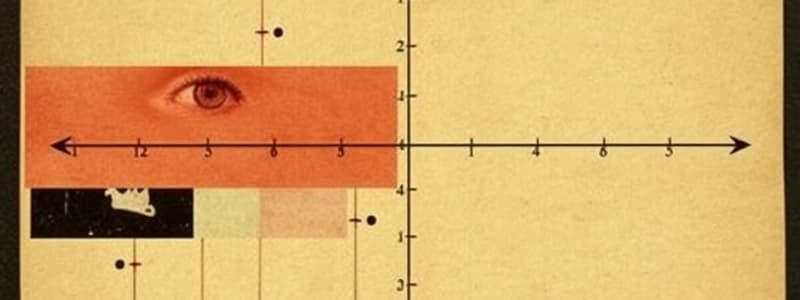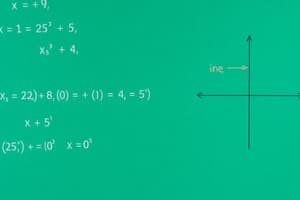Podcast
Questions and Answers
When graphing an inequality, what does a dashed line indicate?
When graphing an inequality, what does a dashed line indicate?
- The solution set includes the line itself.
- The y-intercept of the inequality is zero.
- The inequality does not include 'equal to'. (correct)
- The line is part of a system of equations.
In graphing $y > 2x + 1$, which area of the graph should be shaded?
In graphing $y > 2x + 1$, which area of the graph should be shaded?
- Below the line $y = 2x + 1$.
- Above the line $y = 2x + 1$. (correct)
- To the right of the line $y = 2x + 1$.
- To the left of the line $y = 2x + 1$.
Why is it sufficient to have only two points when graphing a linear inequality?
Why is it sufficient to have only two points when graphing a linear inequality?
- Two points uniquely define a line. (correct)
- Two points establish a curve.
- Two points are enough to find the slope of a line.
- Two points are the minimum required to form any shape.
What is the purpose of testing points on either side of the line when graphing an inequality?
What is the purpose of testing points on either side of the line when graphing an inequality?
Given the inequality $y < -x + 3$, which direction should the graph be shaded?
Given the inequality $y < -x + 3$, which direction should the graph be shaded?
How does the graph of $y \geq x$ differ from the graph of $y > x$?
How does the graph of $y \geq x$ differ from the graph of $y > x$?
What is the first step in graphing the inequality $2x + y < 4$?
What is the first step in graphing the inequality $2x + y < 4$?
Which of the following points would satisfy the inequality $y > x + 2$?
Which of the following points would satisfy the inequality $y > x + 2$?
If a test point (a, b) satisfies the inequality $y \leq f(x)$, what does this tell you about the shaded region?
If a test point (a, b) satisfies the inequality $y \leq f(x)$, what does this tell you about the shaded region?
For the inequality $y < -3$, how would you represent it graphically?
For the inequality $y < -3$, how would you represent it graphically?
If you graph the inequality $y \geq 2x - 1$, and the point (0, 0) is chosen as a test point, what does the result indicate?
If you graph the inequality $y \geq 2x - 1$, and the point (0, 0) is chosen as a test point, what does the result indicate?
How does changing the inequality $y > x$ to $y < x$ affect its graph?
How does changing the inequality $y > x$ to $y < x$ affect its graph?
What is the significance of the absence of the 'equal to' component in inequalities when graphing on the Cartesian plane (e.g., using $<$ or $>$ instead of $\leq$ or $\geq$)?
What is the significance of the absence of the 'equal to' component in inequalities when graphing on the Cartesian plane (e.g., using $<$ or $>$ instead of $\leq$ or $\geq$)?
Suppose you want to express the condition that 'y' must be at least twice 'x' plus five. How would this condition be written and graphically represented?
Suppose you want to express the condition that 'y' must be at least twice 'x' plus five. How would this condition be written and graphically represented?
When graphing $y \leq -x + 1$, a student chooses (0, 0) as a test point and determines that the inequality holds true for this point. How should the student proceed with shading?
When graphing $y \leq -x + 1$, a student chooses (0, 0) as a test point and determines that the inequality holds true for this point. How should the student proceed with shading?
Given the inequality $y > 3x - 2$, explain the implications of choosing a very large value for 'x' when determining the solution set.
Given the inequality $y > 3x - 2$, explain the implications of choosing a very large value for 'x' when determining the solution set.
You've graphed the inequality $y < f(x)$ and noticed that none of your friends shaded the region below the line, even though they all got the line correct. What common error might they have made, and how can you explain the correct procedure?
You've graphed the inequality $y < f(x)$ and noticed that none of your friends shaded the region below the line, even though they all got the line correct. What common error might they have made, and how can you explain the correct procedure?
Considering the graph of $y \geq kx + b$, where 'k' is a very small positive number close to zero, how does the choice of a test point significantly affect determining the correctness of shading?
Considering the graph of $y \geq kx + b$, where 'k' is a very small positive number close to zero, how does the choice of a test point significantly affect determining the correctness of shading?
When graphing an inequality of the form $ax + by < c$ where $b = 0$, what specific graphical characteristic changes, and how does this affect the shading direction?
When graphing an inequality of the form $ax + by < c$ where $b = 0$, what specific graphical characteristic changes, and how does this affect the shading direction?
Flashcards
What are Inequalities?
What are Inequalities?
Symbols that express a non-equal relationship between two values, like <, >, ≤, or ≥.
What do dashed lines signify in graphing inequalities?
What do dashed lines signify in graphing inequalities?
Lines on a graph that represent strict inequalities (i.e., < or >) indicating that points on the line are not solutions.
What does the shaded area on an inequality graph represent?
What does the shaded area on an inequality graph represent?
The area of the graph representing all the solutions that satisfy the inequality.
How to find points for graphing an inequality?
How to find points for graphing an inequality?
Signup and view all the flashcards
When do you shade upwards when graphing inequalities?
When do you shade upwards when graphing inequalities?
Signup and view all the flashcards
When do you shade downwards when graphing inequalities?
When do you shade downwards when graphing inequalities?
Signup and view all the flashcards
How to verify the shaded area?
How to verify the shaded area?
Signup and view all the flashcards
Study Notes
Graphing Inequalities
- Inequalities use symbols such as < (less than) and > (greater than).
- Lines can be solid or dashed when graphing inequalities.
- Dashed lines indicate inequalities that do not include "equal to".
- The area above or below the inequality line is shaded.
Steps to Graphing
- Create a table with x and y values, treating the inequality as an equation.
- Only two points are needed to define a line on the graph.
- Select x values and solve for the corresponding y values in the inequality.
- Determine whether to shade above or below the line by testing points.
- Shade upwards on the graph if the y value is "greater than".
- Shade downwards on the graph if the y value is "less than".
- Verify the correct area is shaded by picking points on either side of the line and substituting them into the inequality.
Studying That Suits You
Use AI to generate personalized quizzes and flashcards to suit your learning preferences.




